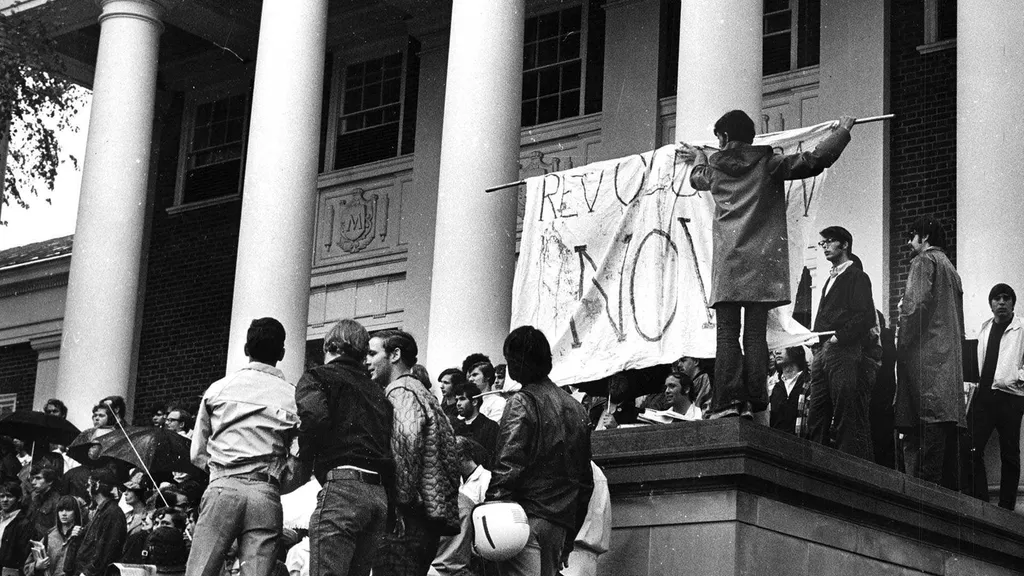- May 04, 2023
- By Sala Levin ’10
University of Maryland students had already begun their fourth consecutive day of anti-war demonstrations on May 4, 1970, when Ohio National Guardsmen fatally shot four protesters at Kent State University.
Even before those killings shook the country and college campuses nationwide, Maryland was in turmoil: clashes between students and police, massive demonstrations, shutdowns of Route 1, a student strike and vandalism at campus buildings. Gov. Marvin Mandel called a state of emergency and sent the National Guard to UMD.
Yesterday, to mark the anniversary of the historic events, University Libraries hosted a group of alums who were active in the anti-war cause in Hornbake Library to share their experiences at “30 Days in May: Reflections on the Antiwar Movement at UMD,” named after the 1970 account of the protests written by the student group Democratic Radical Union of Maryland. (The event was originally scheduled for 2020, the 50th anniversary, but was postponed due to the pandemic.)
A pop-up exhibit, curated by the Libraries’ Special Collections and University Archives, features photos and recollections of that time period and is also on display at Hornbake through tomorrow. University Archives is also collecting oral histories from other alums who were there at the time.
“The war in Vietnam was the defining moment of our generation,” said Richard Fox ’72, who was a member of Students for a Democratic Society. President Richard Nixon’s April 30 announcement of the U.S. invasion of Cambodia sparked widespread outrage and turned what had been a quiet drumbeat of anti-war activism in College Park into a deafening roar.

On May 1, students gathered on McKeldin Mall and, after hearing from several speakers, descended upon Reckord Armory, home to the ROTC. Protesters entered the ROTC offices, and soon “any objects on any desk got thrown out the window, any ROTC uniforms got thrown out the window,” said Craig Simpson ’73. From the Armory, protesters marched on to Route 1, where more than 1,000 students blocked traffic and soon confronted state troopers and Prince George’s County police who were armed with batons and tear gas. Throughout the day, students and police faced off, hurling bottles, eggs, rocks and tear gas back and forth.
Skirmishes continued for days, and on May 6, students at UMD joined their peers across the country in boycotting classes.
For many young people, the Vietnam War represented their first awareness of the nation’s flaws. “I thought that America was always right in all of its wars,” said Linda Zwobota ’74. She changed her mind after seeing an exhibit in Tawes Fine Arts Building (now Tawes Hall) in which an art professor at UMD exhibited charcoal drawings he’d made during his sabbatical in Vietnam in 1969. The drawings depicted prisoners held in brutal conditions by the U.S.-supported South Vietnamese government. “I will never forget how I felt looking at those pictures and then finding out that the U.S. was fully involved in the torture of those people,” Zwobota said.

The May 1970 protests also represented a coming together of a variety of different causes on campus, members of the panel said. The women’s movement, the fight for the rights of Black students and a push for academic freedom all coalesced in opposing the government’s actions, said Barbara Myers ’71.
The alums expressed a hope that students today will take inspiration from the activism of the 1970s. “The lessons for today are the same as they were then,” said Mark Woodard ’73. The key factors, he said, are “people coming together, organizing, fighting for what they believe in, fighting for social justice, fighting for peace. You never know where the ripple’s going to go, and how far and how fast.”
Topics
Campus & CommunityUnits
University Libraries